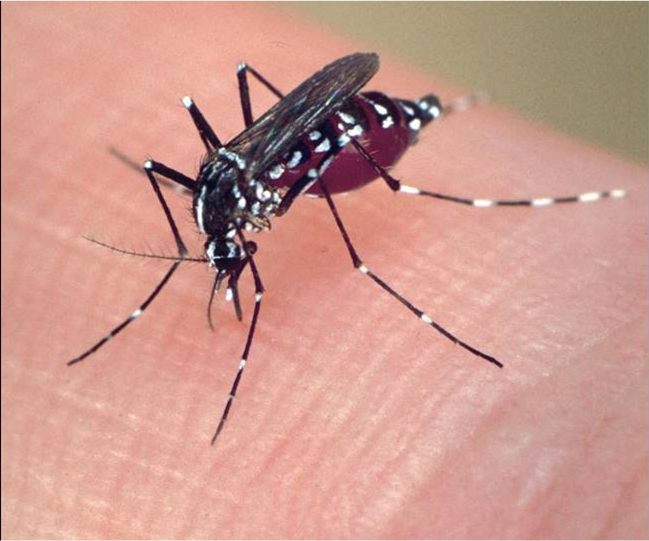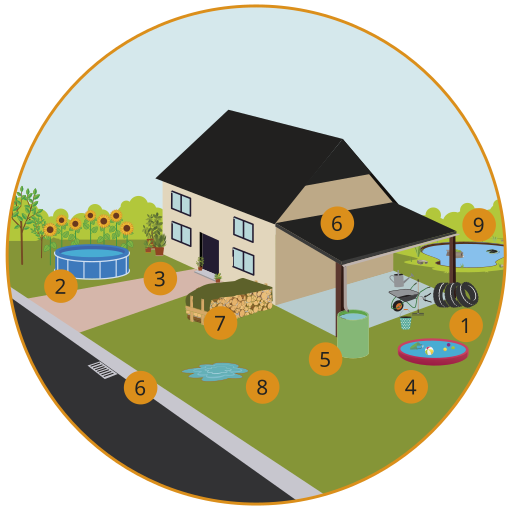Outdoor Delaware is the award-winning online magazine of the Delaware Department of Natural Resources and Environmental Control. Articles and multimedia content are produced by the DNREC Office of Communications.
Just about every single one of us has experienced it. It’s not too hot and you’re sitting outside on a nice summer evening, unwinding after a long day. But you can’t fully relax, because every few minutes you feel a buzz followed by the subtle bite of a bloodthirsty mosquito.
Pretty much any Delawarean would tell you mosquitoes are one of the state’s chief pests, harassing residents and visitors from Claymont to Delmar for about half the year. Naturally, they are particularly prevalent during the summer months, especially in areas near wetlands.
That’s where the mosquito control experts come in. The Delaware Department of Natural Resources and Environmental Control’s Mosquito Control Section has for decades been dedicated to controlling this flying pest. In fact, it has jurisdiction over all public and private properties in the state when it comes to eradicating mosquitoes.
There are about 57 species of mosquitoes in Delaware, although only around one-third bite humans. Still, for many people, one annoying bloodsucking insect is too many, and so the personnel in Mosquito Control take their jobs seriously.

Mosquito Control’s priority is generally treating large coastal wetlands such as tidal marshes and coastal impoundments, especially after rainstorms. A dry spell followed by heavy rain or large tidal event is a potential triggering event that can lead to many mosquitoes hatching and subsequently spreading for miles, said Thomas Moran, DNREC’s Mosquito Control program manager.
“In the days after that, we’re out there checking all those marsh habitats and known hot spots of a big magnitude in the zone where that rain fell,” he said.
DNREC typically has no more than a week in between a triggering event and a mass hatching to control the larvae and prevent them from reaching the adult mosquito life stage.
The experts endeavor to venture out into marshes and other areas after potential triggering events. If they spot a large number of larvae, Mosquito Control will arrange to treat the area aerially.
Mosquitoes lay their eggs either on the surface of bodies of water or moist soil. Those of the latter type are known as floodwater mosquitoes, as their eggs require floods to hatch. These eggs can remain dormant for years while they await water.
When the eggs do hatch and progress from larvae into pupae and then full-blown mosquitoes, they can travel miles in search of suitable food sources. Mosquitoes live anywhere from a few days to several weeks, depending on the species, and some can lay eggs multiple times.
That spread means what happens along the coast can impact our state inland, with, for instance, mosquitoes from Little Creek eventually spreading to Dover if they are left unchecked.
Should there be an emergence of a large number of adult mosquitoes, such as if Mosquito Control is unable to spray an area due to bad weather or simply misses a spot, DNREC can perform further treatment from an airplane to control the adult mosquitoes. An aerial spray contractor will conduct flights over prescribed areas of the state, generally along the coast, spraying insecticide to eliminate those pesky mosquitoes.
The focus of Mosquito Control’s work involves spraying the mosquitoes while still in their larval, aquatic life stage to prevent them from becoming the biting bugs we all hate, essentially cutting the problem off at the source. Once they reach the flying adult stage, they are liable to disperse geographically and lay more eggs.
“As we like to say, it’s a boom-and-bust industry,” Moran said. “We really run, run, run after those triggering events and there’s a lull, and then it’s the next event and back and forth we go.”
For smaller inland areas known to be hot spots, like a low-lying field that can easily collect standing water, Mosquito Control employees will go out using backpack sprayers to painstakingly treat sources with granular insecticides.
Of course, no matter what the Section does, there will still be areas plagued by adult mosquitoes. That’s when DNREC will resort to its five fog trucks. On any given night during the summer, typically one or two will be in use spraying in various areas throughout the state.

Much of Mosquito Control’s attention also goes to addressing concerns raised by individual residents calling in to report large numbers of mosquitoes in their yards.
“As the joke goes, all mosquito control is local,” Moran said.
Work really ramps up in mid-March and continues until about the middle of October, after which mosquitoes are not much of an issue for several months.
The Section’s workforce will grow to about 25 employees between full-time and seasonal personnel during the summer months. During the offseason, roughly defined as November through February, Mosquito Control experts focus on processing data to search for trends, conducting professional development and planning for the next mosquito season.
While mosquitoes are really only noticeable when temperatures rise above 55 degrees, which leaves out about a third of the year, climate change in the coming decades could cause mosquito season to last as long as 10 months, according to experts.
Mosquito Control strives to keep the public informed so Delawareans know where and when sprayings will take place and can avoid them as much as possible, though even in this age of seemingly endless tools for communication it can be impossible to reach everyone. (To receive updates about sprayings, visit dnrec.delaware.gov/fish-wildlife/mosquito-control/mosquito-spraying/.)
Because of that, spraying marshes and similar areas for larvae is always preferable to spraying for adult mosquitoes in and near communities, Moran said.
Mosquito Control uses chemicals like Bti, methoprene and Spinosad, which are green and safe for people and animals. The Section rotates between different substances to avoid mosquitoes building a resistance to any one insecticide, as has happened in some southern states that spray for mosquitoes more often.
DNREC might spray one area up to about half a dozen times in one season.
Controlling adult mosquitoes becomes harder once fall hits because temperatures drop, and thus the window for spraying when mosquitoes are active shrinks. This is coupled with the fact that earlier sunsets and later sunrises means spraying has to occur when there is a greater chance of more human exposure and thus possible complaints.
Anyone who’s experienced the frustration of being continually bitten by mosquitoes would probably vouch for why mosquito control is necessary, but even if it’s not immediately obvious, the practice has important benefits. Not only does having fewer mosquitoes enhance quality of life, it lowers the risk of the insects transmitting diseases to humans. West Nile virus, which is occasionally fatal, can be transmitted from birds to humans by some mosquito species, for instance.
Some of the peskiest species here include the daytime invasive Asian tiger mosquito (Aedes albopictus) and the saltmarsh mosquito (Aedes sollicitans), the main nuisance at our coastal resorts.
Typically, our main mosquito disease of concern, West Nile virus, is most prevalent in August and September, as that’s when mosquito species that lay their eggs on the surface of bodies of water peak. Those months also have the highest number of “older” female mosquitoes that have likely had many bloodmeals and in turn have the greatest chance of picking up a disease-causing pathogen.
DNREC’s main disease surveillance tool is sentinel chicken flocks, with experts carefully monitoring the birds for sicknesses like West Nile.

Mosquito Control also has an important economic component by enabling beach tourism, as pioneered by New Jersey in the early 1900s. With trains becoming a regular fact of life for many those living in or near cities on the East Coast, people started taking vacations along the Jersey Shore, Moran said. But New Jersey needed a way to protect people from the biting mosquitoes that came from the salt marshes prevalent along the state’s coast.
Thus, mosquito control was born, though it was still in its infancy. It wasn’t until after World War II that modern mosquito control really came into being, the result of advancements in insecticide and aerial spraying technology and better scientific understanding of mosquito biology, Moran said.
Suburbs started growing in the 1950s in areas previously dominated by farmland, wetlands and other natural spaces, and the residents of these new communities came to learn what many farmers already knew: mosquitoes can be a real nuisance.
Out of a desire to eradicate malaria and other mosquito-borne diseases of the time and to keep citizens free from biting insects, Delaware law granted Mosquito Control broad authority to spray public and private property as the need requires.
“Our probable cause is there could be mosquitoes. That’s a pretty blanket probable cause when you think about it,” Moran said, noting DNREC would essentially be working with its hands tied behind its back if the agency had to get permission from every single homeowner to operate on their property.
“If you call us and we come to your house because you say the mosquitoes are bad and we’re looking around but we start seeing your neighbor’s yard or some ditch behind your house that goes behind all your neighbors’ yards and that ditch is actually on each of their properties, we follow the ditch where it leads,” Moran said “As we’re walking that ditch, we’re looking into those neighbors’ yards. If there’s a little kiddie swimming pool with ankle-deep water, a bunch of buckets, a wheelbarrow, a tarp or a boat with a plug in it full of rainwater, we just need to be able to inspect those potential sources and do our thing as necessary.”
Although preventing disease remains important, mosquito control today is largely nuisance-driven thanks to the success of modern medicine in nearly eliminating once-deadly diseases like malaria, as well as due to creature comforts like window screenings and air conditioning.
Some people even turn to private companies capable of utilizing a spray that can essentially act as a barrier around one’s property, thus keeping mosquitoes from flying into a yard, Moran said. This technology is too impractical to be economical for the Mosquito Control Section, however, plus it can be harmful to beneficial insects.
Ultimately, while there probably isn’t a soul in Delaware who is happy to see mosquitoes, residents should keep in mind Mosquito Control cannot work magic. Demand outpaces what the Section can supply at times, and the experts must take into account things like weather conditions.
“It’s not just see mosquitoes, spray mosquitoes,” said Moran, who has been in the business for more than 33 years. “It’s not that simple.”
It’s a careful balancing act between controlling mosquito populations and protecting human health and also being mindful of other wildlife and natural habitats.
So, in addition to calling DNREC Mosquito Control or a private service, what can you do to avoid being eaten alive?

Mosquitoes are most active at dawn, dusk and night, so staying indoors at these times can help you avoid a lot of bites. If you do venture outside, wear long sleeves or apply insect repellent.
Mosquitoes are attracted to body heat, sweat and the combination of scents like perfumes, colognes and body sprays. They also tend to favor individuals wearing dark clothes over light-colored ones.
Burning citronella candles or tiki torches or using fans or butane-powered devices can provide limited repellent qualities for a small outdoor area. Bug zappers are not recommended, as they often end up killing many harmless insects instead.
Finally, eliminate standing water! Whether it’s in an empty flowerpot, a corrugated downspout, a tarp, a bucket, a tire, clogged roof gutters, a boat, an unused swimming pool or anything else that can collect water, there are many potential breeding grounds for mosquitoes immediately around a home.
If you are bitten by a mosquito, try to avoid scratching the spot. Apply an over-the-counter anti-itch product to relieve the sensation if necessary.
Related Topics: animals, health and science, insects, mosquito, mosquito control, outdoor delaware, public health